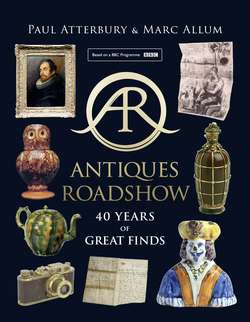Читать книгу Antiques Roadshow: 40 Years of Great Finds - Paul Atterbury, Paul Atterbury - Страница 13
PAUL STORR SALTS
Оглавление‘They were the most beautiful sculptural objects and made by one of our greatest-ever silversmiths.’
Brand Inglis
A curious fact of Roadshow life is that some of its greatest finds only just make it onto the show. Typical is the story of the set of four Paul Storr salt cellars filmed at Salisbury Cathedral in 1990. The owner came to reception with one of the salts in a brown paper bag, thinking it was made of brass and wanting to know what it was. Penny Brittain, then working on reception, saw the Paul Storr mark and asked him if he had any more. When told there were three more, Penny begged him to go home and fetch them without, of course, revealing anything about them. The owner was reluctant but agreed when offered a taxi to take him home. He did not reappear for ages and everyone had almost given up hope. Finally, near the end of the show, he returned with his wife and all four salts and was filmed by expert Brand Inglis as the last item of the day.
SILVERSMITH TO ROYALTY
Paul Storr (1771–1844) is generally considered to be the most important of the silver and goldsmiths working in Britain during the Regency period. He registered his mark at Goldsmiths’ Hall in 1792, having served a seven-year apprenticeship with the influential, London-based silversmith Andrew Fogelberg, and during the next thirty years developed his reputation as the most creative silversmith of his time. He worked initially on his own and later with the famous firm of Rundell & Bridge. In 1805, the company became Rundell, Bridge & Rundell, and included among its clients some of the wealthiest and most influential people in Britain, including George III, the Prince Regent, and their consorts. Storr designed and made many of these prestigious pieces. He become a partner in the business in 1811 but left ten years later to start his own business in partnership with John Mortimer, continuing to design and make fine things until his retirement in 1839.
Paul Storr’s fame as a silversmith is based on his exceptional technical virtuosity, his attention to detail and finish and his creative imagination. It is widely believed that none of his contemporaries could match his particular skills.
The four silver gilt salts were modelled as shells supported by mermaids and mermen. Three carried marks for 1813 and one for 1811, along with the maker’s mark for Paul Storr. During the filming, Brand Inglis suggested that the inspiration for the fluid, revived Rococo design may have come from an eighteenth-century piece by the silversmith Nicholas Sprimont (later the founder of the Chelsea porcelain factory) in the Royal Collection at Windsor Castle. He felt that, as Storr was frequently working for the Royal family, he could have had ample opportunity to see and admire pieces in the Royal Collection at Windsor. The Regency period in Britain was famous, not only for the extravagant lifestyle of the monarchy and those associated with it, but also for inventive and elaborate styles of design, particularly in the decorative arts. There were many influences, including earlier styles such as Gothic, Rococo and Classical, along with a taste for the exotic, the latter notably underlined by the famous Royal Pavilion in Brighton. At the same time, there was a dawning awareness of the importance of the Renaissance, with the salts also reflecting the styles associated with artists such as Cellini. There is a set of three similar salts in the collection of the Virginia Museum of Fine Arts in the United States, perhaps based on a design by the English sculptor William Theed.
A MUCH UNDERRATED TREASURE
The owner, a quiet man clearly surprised by the whole filming process and the excitement generated by the salts, knew little about them. He had not considered them to be of any value, and said that his parents, who had been in service, had been given the set as a retirement present. His father had passed them on to him before his death six years ago, and since then they had lived in a plastic bag at the bottom of a bedroom cupboard. His response to Brand’s valuation of £40,000 was to say: ‘If my daughter-in-law hadn’t told me the Roadshow was coming to Salisbury, the salts would still be sitting at the bottom of that cupboard. If anything had happened to my wife and I, the children would have had no idea of their value. They would probably have gone in a job lot house clearance.’
Later, the salts were sold at auction for £66,000 to the Salters’ Company and are now in Salters’ Hall in the City of London.
